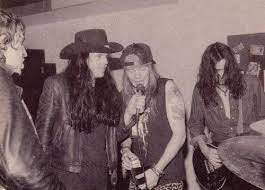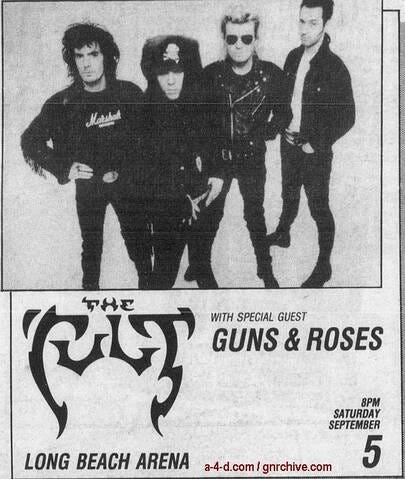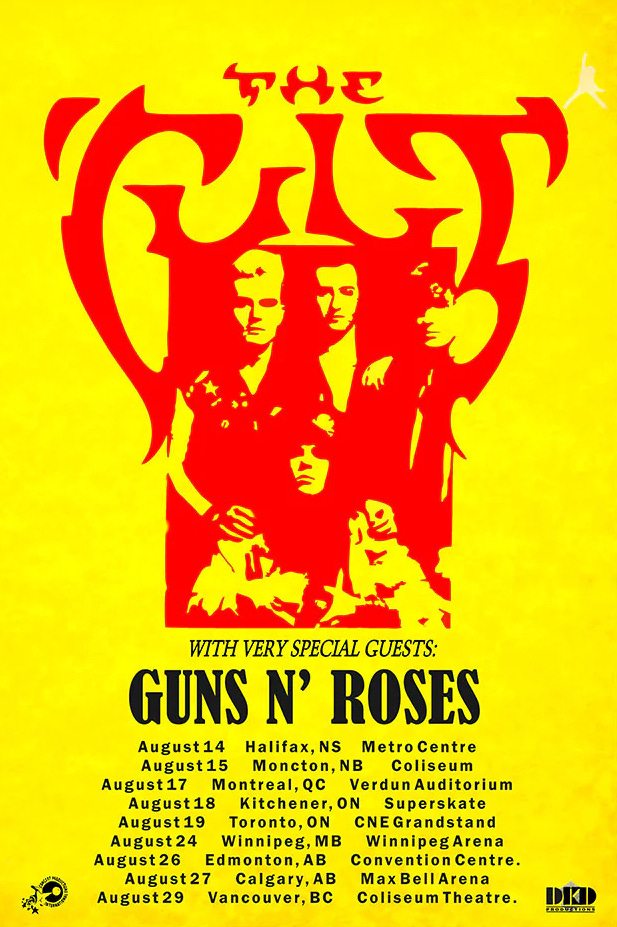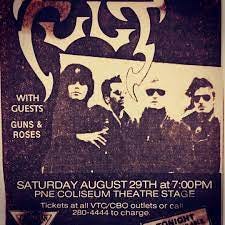The Cult and Guns N’ Roses: How One Tour Changed Rock History
Every legendary band has a moment of reckoning—a time when they go from being just another group to a force of nature.




by André Paul Pinces
Rock history is filled with pivotal moments—tours, performances, and chance encounters that shape the trajectory of bands and entire movements. For Guns N’ Roses, that moment arrived in 1987 when they joined The Cult on tour. At the time, GN’R were still a scrappy, volatile club band, hungry for a shot at something bigger. The Cult, on the other hand, were already a headlining act, straddling the line between post-punk’s shadowy cool and the hard rock resurgence of the late ‘80s.
Before Appetite for Destruction turned Guns N’ Roses into the most dangerous band in the world, The Cult put them in front of their first major arena crowds. It was a collision of timing, influence, and pure rock and roll survivalism. The Cult didn’t just open a door for GN’R—they catapulted them toward a future that may never have arrived so quickly otherwise.
From Post-Punk to Hard Rock: The Cult’s Evolution
The Cult didn’t start as a hard rock band. In fact, their early days were spent in the UK’s post-punk and gothic rock underground, far from the bombast of arena stages. Ian Astbury, the band’s magnetic frontman, had first emerged with Southern Death Cult, a tribal, politically charged post-punk act that never made it past its first year. When that project folded, Astbury stripped things down, linking up with guitarist Billy Duffy (formerly of Theatre of Hate) to form Death Cult—a band that leaned harder into rock’s dramatic potential.
By 1984, they dropped the “Death” from their name, simply becoming The Cult, and fully embraced their evolution. Their first few albums still carried echoes of their gothic roots, but by Love (1985), they were writing anthems. “She Sells Sanctuary” was a shimmering, widescreen epic that hinted at something grander, something that belonged in larger venues. That shift became undeniable with Electric (1987), the album that redefined The Cult as a full-fledged hard rock band.
Produced by Rick Rubin, Electric was raw, stripped-down, and aggressive—a record that owed more to AC/DC than Joy Division. Gone were the layers of reverb and gothic mysticism; in their place were tight, bluesy riffs and a sneering, swaggering attitude. Tracks like “Love Removal Machine” and “Wild Flower” felt like they belonged in the same universe as the new wave of L.A. rock bands clawing their way up through the clubs. It was here that their paths intersected with Guns N’ Roses.
1987: The Tour That Launched GN’R
In 1987, Guns N’ Roses weren’t yet household names. Appetite for Destruction was still months away from blowing open the doors of mainstream rock, and at the time, they were still viewed as just another reckless, up-and-coming band with a dangerous reputation. But The Cult saw something more.
When it came time to pick an opener for their North American tour, they chose Guns N’ Roses—not because they were industry darlings, but because they were raw, real, and teetering on the edge of something explosive. This wasn’t just an opening slot; it was an opportunity for GN’R to prove they could command an arena, night after night.
And they did.
The tour was chaotic, as expected. The Cult and Guns N’ Roses weren’t exactly models of restraint, and their time on the road together became the stuff of legend—wild afterparties, close calls with the law, and a backstage atmosphere that often blurred the line between camaraderie and outright competition. Ian Astbury reportedly gave Axl Rose one of his most enduring style tips—telling him to ditch his teased-up hair in favor of a bandana and straightened locks. Billy Duffy later recalled Axl standing in the wings every night, studying Astbury’s every move, learning how to command a stage with more than just raw energy.
The Cult’s presence also forced Guns N’ Roses to sharpen their act. If they were going to step out in front of thousands of people every night, they couldn’t afford to be sloppy. They had to rise to the occasion, to prove that they weren’t just a great club band but something more—something that belonged in stadiums.
And it worked.
By the time the tour wrapped, Guns N’ Roses weren’t just another opening act—they were a band on the verge of something massive.
The Explosion of Appetite for Destruction
A few weeks after the tour ended, Guns N’ Roses released Appetite for Destruction. At first, it barely made a dent. The album wasn’t an instant smash—MTV refused to play “Welcome to the Jungle,” radio stations weren’t sure what to do with them, and the industry seemed hesitant to embrace a band that felt genuinely dangerous.
Then, MTV relented. They aired the “Welcome to the Jungle” video in a 3 AM slot, and the reaction was immediate. Calls flooded in, demand skyrocketed, and suddenly, Guns N’ Roses went from a struggling band with a cult following to the biggest rock act on the planet. Appetite became the highest-selling debut album of all time, fueled by singles like “Sweet Child o’ Mine” and “Paradise City.”
Would this have happened without The Cult’s tour? Eventually, maybe. But that run of arena shows in 1987 accelerated the process, giving GN’R the battle-hardened edge they needed to dominate.
The Cult & GN’R: A Lasting Connection
Even as their paths diverged, The Cult and Guns N’ Roses remained connected. When GN’R launched their massive Not in This Lifetime reunion tour in 2016, The Cult was one of the bands invited to open. Ian Astbury has often spoken of his admiration for Guns N’ Roses’ staying power, while Slash and Billy Duffy have shared mutual respect over the years.
But beyond personal connections, the deeper legacy of that 1987 tour is what it meant for rock as a whole. It was one of the last moments before rock and roll changed forever—before the excess of the late ‘80s turned into the grunge-driven nihilism of the early ‘90s. The Cult and Guns N’ Roses, in their own ways, represented the last great era of true rock star mythology—dangerous, unpredictable, larger than life.
Without The Cult, there’s a chance Guns N’ Roses wouldn’t have gotten their first real shot. And without Guns N’ Roses, The Cult’s impact on ‘80s rock might have faded faster than it did.
Together, they were part of something bigger. They were part of the last great wave of rock and roll before the industry changed, before the danger faded, before everything that once felt unpredictable became just another product.
And for that, their paths will always be intertwined.
André Pinces is a commercial photographer and director based in Vancouver, specializing in bold, cinematic portraiture and editorial storytelling. His work spans fashion, lifestyle, and brand-driven campaigns, collaborating with agencies and creative teams to craft striking visual narratives.
Website: pincesphoto.com
Instagram: @pincesphoto
Inquiries: DM for collaborations
Keywords: commercial photography, editorial, portraiture, visual storytelling, filmmaking, Vancouver, fashion, lifestyle, brand campaigns



